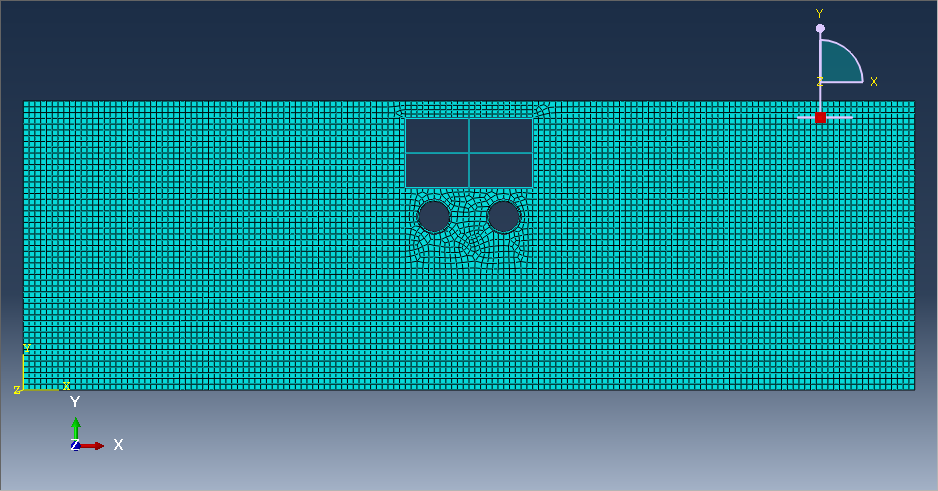交叉地下结构地震响应分析毕业论文
2020-04-12 14:22:44
摘 要
随着我国城市对地下空间的推进开发,地下空间的利用率不断提高,地下结构之间的位置关系越发巧妙,交叉、平行、贯通等都是一些常见的地下结构相对位置关系,而新建地下结构对原有结构必然产生影响,地下结构与周围土体必然形成一个复杂的相互作用体系。本文结合实际工程建立隧道平行下穿地铁车站计算模型,探讨交叉地下结构对土体地震响应的影响,分析结构及体系的地震响应规律。
首先建立四种计算模型,即自由场模型、土-隧道模型、土-地铁车站模型及隧道-土-地铁车站模型,分别将两种地震波(EL-Centro波和Kobe波)依次输入至各工况进行计算,并根据计算结果对比分析各工况的加速度及位移响应变化规律,得出新建地下结构对原有结构的影响规律、新建地下结构对周围土体的影响规律。结果表明:(1)软土场地对地震波具有放大效应,地下结构对场地土特性的影响很小,但对场地土地震响应的影响不容忽视,总体上削弱了地表的加速度响应;(2)下卧隧道的存在总体上降低了车站结构的加速度响应,在二者间距较小时,隧道对车站的影响不容忽视,隧道对车站变形的影响总体上较其对车站加速度影响要小,以降低为主;(3)车站的存在对下卧隧道加速度影响规律不一致,总体上表现为降低,车站的存在整体上放大了隧道的变形,随着车站与隧道距离的增大,车站对隧道的影响程度减小。
本论文的研究方法和结果对进一步分析交叉地下结构在地震时的相互影响规律有重要的意义。
关键词:地铁车站;盾构隧道;交叉结构;地震响应;
Abstract
With the development of underground space in cities of our country, the utilization rate of underground space is increasing, and the location relationship between underground structures is more and more ingenious, cross, parallel, penetrating and so on are some common relative position relationships of underground structures. However, the new underground structure must have an influence on the original structure, and a complex interaction system between the underground structure and the surrounding soil must be formed. In this paper, the calculation model of tunnel parallel underpass subway station is established, the influence of cross underground structure on soil seismic response is discussed, and the seismic response law of structure and system is analyzed.
Firstly, four kinds of computing models are established, that is, free field model, soil-tunnel model, soil-subway station model and tunnel-soil-subway station model. Then, two kinds of seismic waves, EL-Centro wave and Kobe wave, are input to each working condition in turn to calculate, and the law of acceleration and displacement response of each condition is analyzed according to the calculated results. The influence of the new underground structure on the original structure and the influence of the new underground structure on the surrounding soil mass are obtained. The results show, (1) Soft soil site has magnification effect on seismic wave, and underground structure has little influence on site soil characteristic, but the influence on site soil seismic response can not be ignored, and the acceleration response of ground surface is weakened in general. (2) The existence of the lying tunnel reduces the acceleration response of the station structure on the whole. When the distance between the two is small, the influence of the tunnel on the station can not be ignored, and the influence of the tunnel on the deformation of the station is generally smaller than that on the acceleration of the station, to reduce the main. (3) The existence of the station has different influence on the acceleration of the underlying tunnel. The existence of the station amplifies the deformation of the tunnel as a whole. With the increase of the distance between the station and the tunnel, the influence of the station on the tunnel decreases.
The research methods and results of this paper are of great significance for further analysis of the interaction of cross underground structures during earthquakes.
Key words: Subway station; Shield tunnel; Cross structure; Seismic response.
目录
第一章 绪论 1
1.1引言 1
1.2国内外研究现状 1
1.2.1地下穿越工程实例总结 1
1.2.2地下穿越工程特点总结 4
1.2.3研究现状 5
1.3研究内容 7
第二章 计算模型及计算工况 8
2.1计算模型 8
2.1.1计算范围及边界条件 8
2.1.2本构模型及计算参数 9
2.1.3动力时步及地震波输入 10
2.2计算工况 10
2.3监测方案 11
2.4小结 12
第三章 数值计算结果分析 13
3.1模态分析 13
3.2地下结构对周围土体的影响分析 13
3.3隧道结构对地铁车站结构的影响分析 18
3.3.1加速度分析 18
3.3.2变形分析 20
3.4地铁车站结构对隧道结构的影响分析 22
3.4.1加速度分析 22
3.4.2变形分析 24
3.5小结 25
第四章 结论与展望 26
4.1结论 26
4.2展望 26
参考文献 27
致谢 29
第一章 绪论
1.1引言
多年以来,我国就一直处于高速发展阶段,尤其是近几年,我国的发展模式由高速转向高质量发展。高速的发展已经为我们带来了便捷的出行方式,然而可见的地面空间始终有限,为了缓解拥堵的地面交通,我国正在大量发展地下结构。地铁车站与隧道等空间交叉结构逐渐发展,并且随着城市轨道交通快速发展以及地铁施工技术的日渐成熟, 地下交错架构变得越发普遍,穿越施工工程越来越多,包括上穿和下穿,且以下穿为主。由于地下结构往往不是一个独立的结构,而且全部埋置于地基土中,其地震反应必然与地上结构不同,主要受周围土体的地震反应影响,而地下交叉结构又涉及相互联系、相互作用的两个结构,其地震响应自然比独立的结构更加复杂,然而,目前相关研究尚不全面。本文将以隧道下穿地下车站结构为模型,建立计算模型,在现有基础上深入探索交叉地下结构的地震动反应,分析整个体系在地震时的响应规律。本文的研究成果可为交叉地下结构的抗震设防设计提供一定依据。
1.2国内外研究现状
1.2.1地下穿越工程实例总结
随着城市轨道交通系统的迅速发展,诸多城市已完成了第一轮建设,陆续开展了第二轮,甚至第三轮的轨道交通建设。限于有限的城市 地下空间资源以及前期规划等原因,大量的相互穿越工程涌现出来。基于这个背景,结合下面我查阅的文献,整理下目前相互穿越工程的案例。主要分为以下几类:
1,隧道之间的相互穿越:
2,隧道上穿地铁车站(即地铁车站下穿隧道):
3,隧道下穿地铁车站(即地铁车站上穿隧道):
4,地铁车站之间的相互穿越:
表1.1隧道之间的相互穿越











